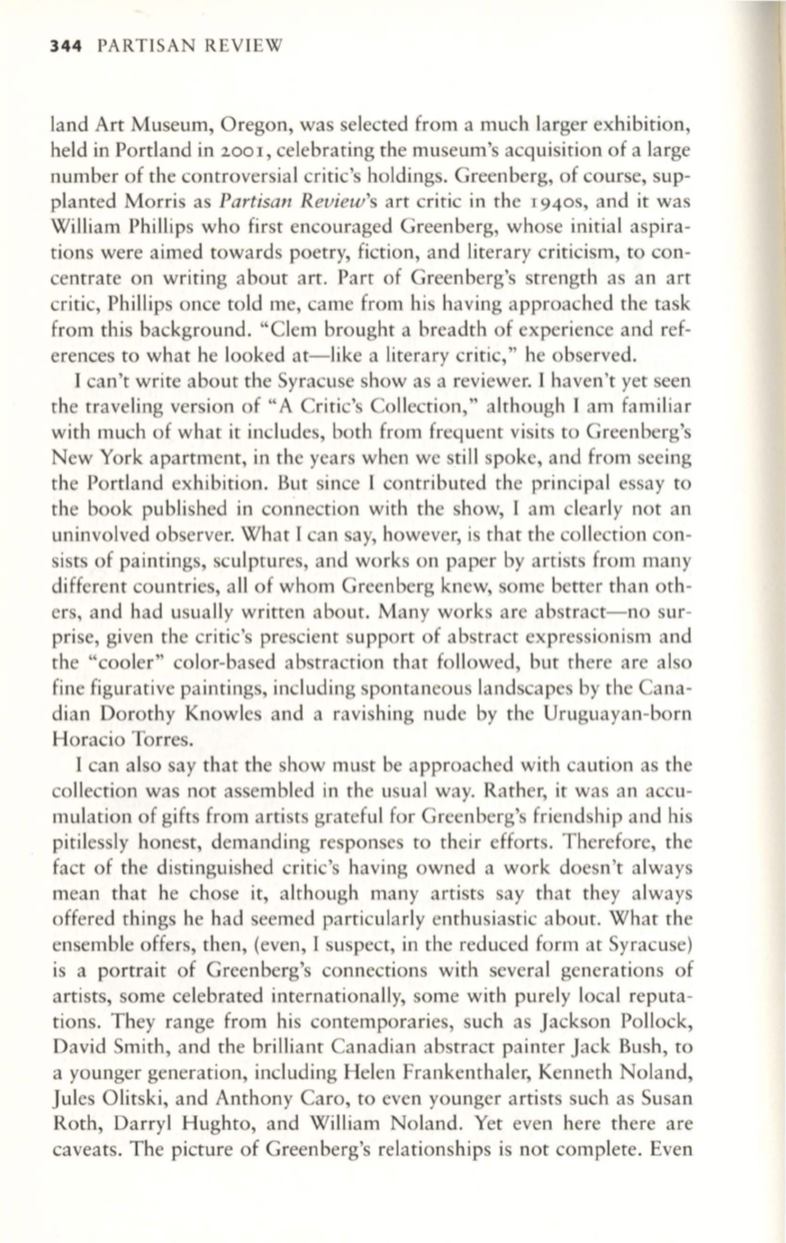
344
PARTISAN REVIEW
land Art Museum, Oregon, was selected from a much larger exhibition,
held in Portland in 200I, celebrating the museum's acquisition of a large
number of the controversial critic's holdings. Greenberg, of course, sup–
planted Morris as
Partisan Review's
art critic in the 1940s, and it was
William Phillips who first encouraged Greenberg, whose initial aspira–
tions were aimed towards poetry, fiction, and literary criticism, to con–
centrate on writing about art. Part of Greenberg's strength as an art
critic, Phillips once told me, came from his having approached the task
from this background . "Clem brought a breadth of experience and ref–
erences to what he looked at-like a literary critic," he observed.
I
can't write about the Syracuse show as a reviewer.
I
haven't yet seen
the traveling version of "A Critic's Collection," although
I
am familiar
with much of what it includes, both from frequent visits to Greenberg's
New York apartment, in the years when we still spoke, and from seeing
the Portland exhibition. But since
I
contributed the principal essay to
the book published in connection with the show,
I
am clearly not an
uninvolved observer. What
I
can say, however, is that the collection con–
sists of paintings, sculptures, and works on paper by artists from many
different countries, all of whom Greenberg knew, some better than oth–
ers, and had usually written about. Many works are abstract-no sur–
prise, given the critic's prescient support of abstract expressionism and
the "cooler" color-based abstraction that followed, but there are also
fine figurative paintings, including spontaneous landscapes by the Cana–
dian Dorothy Knowles and a ravishing nude by the Uruguayan-born
Horacio Torres.
I
can also say that the show must be approached with caution as the
collection was not assembled in the usual way. Rather, it was an accu–
mulation of gifts from artists grateful for Greenberg's friendship and his
pitilessly honest, demanding responses to their efforts. Therefore, the
fact of the distinguished critic's having owned a work doesn't always
mean that he chose it, although many artists say that they always
offered things he had seemed particularly enthusiastic about. What the
ensemble offers, then, (even,
I
suspect, in the reduced form at Syracuse)
is a portrait of Greenberg's connections with several generations of
artists, some celebrated internationally, some with purely local reputa–
tions. They range from his contemporaries, such as Jackson Pollock,
David Smith, and the brilliant Canadian abstract painter Jack Bush, to
a younger generation, including Helen Frankenthaler, Kenneth Noland,
Jules Olitski, and Anthony Caro, to even younger artists such as Susan
Roth, Darryl Hughto, and William Noland. Yet even here there are
caveats. The picture of Greenberg'S relationships is not complete. Even


